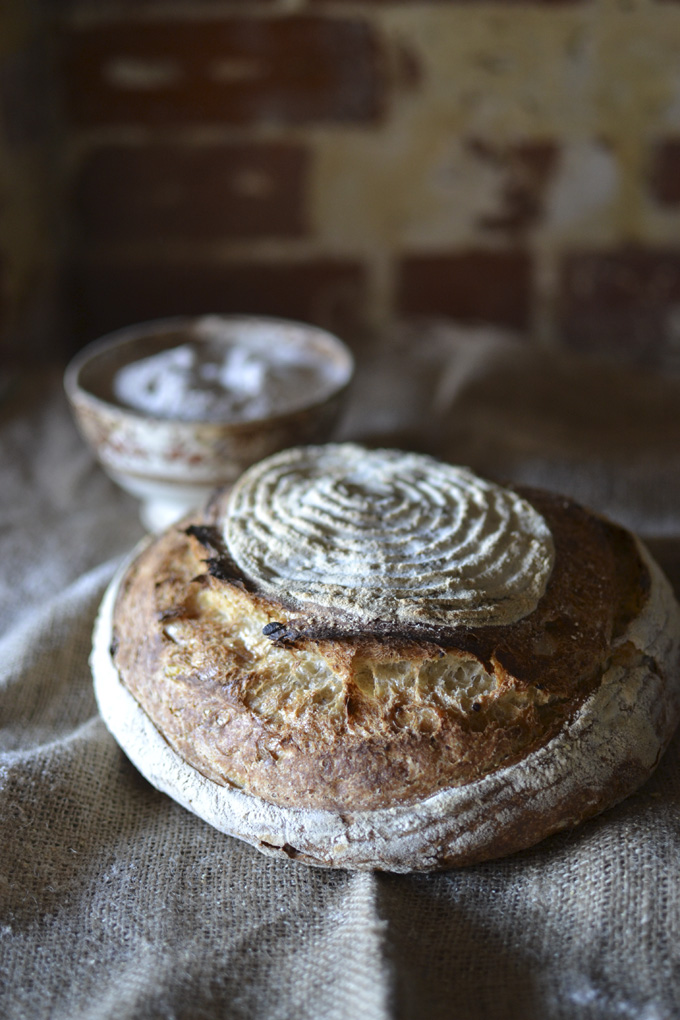
NOTE THIS RECIPE WAS DEVELOPED AND ADDED TO THE CLUB IN 2014 – It does not follow the up to date format but we have left it here for posterity.
If you have been a little over-enthusiastic with the amount of mashed potato you have made then this recipe is a superb way to use up leftovers. Ironically in Elizabeth David’s book English Bread and Yeast (1977), she states that potato bread is “Usually associated with times of grain shortage, or with a need for strict economy in the kitchen.” Certainly, potatoes have been used in bread for hundreds of years and were often used to get a leaven going before the invention of compressed yeast because they are particularly easy to ferment.
In The Science and Art of Bread Making by William Jago, published in 1895 Jago he warns bakers than potatoes are a stimulant and explains that “roughly speaking a potato contains three-quarters of it’s weight water and about 15 per cent of starch and the remainder being made up of percentages of proteins, dextrin sugar and other substances.” Jago goes on to suggest using less yeast “because of the nitrogenous matter effect of potato still acts as a yeast stimulant to the sponge.” He was not wrong, this is a lively dough so to control the rate of the ferment I have pre-fermented the potato. Adding potato certainly makes a beautiful dense moist earthy loaf. It has a wonderful crunchy crust and tastes sweeter when toasted. The addition of potato also has the advantage of making you feel fuller than normal sourdough. If you use leftover mash from a previous meal to make this loaf then do remember to alter the salt ration accordingly or you may end up with overly salted bread.
Ingredients
I used 00 flour and Priors wholemeal
To make 2 large loaves
LEAVEN
120g 1:1 starter
375ml cold water
400g cooked mashed potatoes ( I use organic ones)
275g strong white 00 organic bread flour
100g organic wholemeal flour
___________________
400ml water at 27 (Summer) 28 (Winter) degrees Celsius
1kg strong white 00 organic bread flour,
50ml water
18g British sea salt,
Organic polenta for dusting.
Get your ferment Ready.
8 – 12 hours before you make your bread, put your starter in a bowl large enough to mix the whole recipe in. Add your water and potatoes and mix well. Stir in both the 00 and wholemeal flour, cover and leave for 8 – 12 hours
Let this rest in a cool place for 8 to 12 hours. It will double in size.
Make Your Dough
Add the remaining 400 ml of water and white bread flour.
Rest your Dough 30 minutes
Let rest in a cool, dark place for 30 minutes. (This is called *Autolyse)
The flour has the chance to absorb the water fully before you start activating the gluten.
Add salt to the 50 grams warm water and then mix into the dough. Don’t worry if it looks too wet .. it will change. Fold dough rather then stirring. Cover the bowl with a shower cap then a tea towel. Let rest for about 30 minutes.
1st Fermentation & folds.
The dough will now begin its first fermentation. (The first fermentation takes about 3 to 4 hours depending on the ambient temperature)
Instead of kneading, I allow the dough to develop through a series of “folds” in the bowl during this first fermentation. Fold dough, repeating every 40 minutes.
To do a fold it helps if you dip 1 hand in the water – it prevents sticking or use a really light Fairtrade olive oil on your hands. Take the underside of the dough, stretch it out, and fold it back over itself. Rotate the bowl a quarter turn. Repeat. Do 2 full turns of your bowl for each fold. After about 3 hours, the dough should feel aerated. Use your judgment. On a hot day, it will take less time for the dough get about a 30 per cent increase in volume.
Folds for structure
Really gently transfer the dough to a floured surface. Lightly dust the dough with flour, and cut into two pieces. Form gently into a balls and
Work each piece into a round. Then as the tension builds and the dough slightly sticks rotate and drag it. By the end, the dough should have a taut, smooth surface, which will give your bread a good really crust.
With your dough scraper, transfer both to really well-dusted banneton baskets with the smooth side down, Your seam from underneath should now be centred and facing upwards. Pinch together any open dough.
2nd Fermentation
Let rest at room temperature until proved – about 4 – 6 hours.
Bake your Bread
About twenty minutes before you need bake your sourdough, preheat your oven to 220 degrees, warm a 30cm -inch heavy ovenproof pot with a tight-fitting lid. Personally I favour using a La cloche baking dome. Dust the bottom of your pan liberally with polenta to stop your sourdough loaf from sticking.
Turn your the first of your sourdoughs one at a time out of the basket gently into your bakeware and using a blade or a sharp knife score. Cover with lid. Return to oven, and reduce oven temperature to 200 degrees.
After 25 minutes remove the lid and bake until crust is deep brown – don’t be tempted to remove early. This should take about 20 to 25 minutes. Always transfer your loaf to a wire rack. You can tell that is cooked as it will feel light and sound hollow when tapped on the bottom.
Repeat for the baking process for your second loaf.
*Autolyse – This refers to a period of rest after the initial mixing of flour and water and it gives the flour a chance to absorb water without the inhibiting presence of salt and leavening and so helps the gluten and starches to align which leads to better dough development and better flavour as well. . Bread made with autolysed dough are easier to shape and have more volume and improved structure.
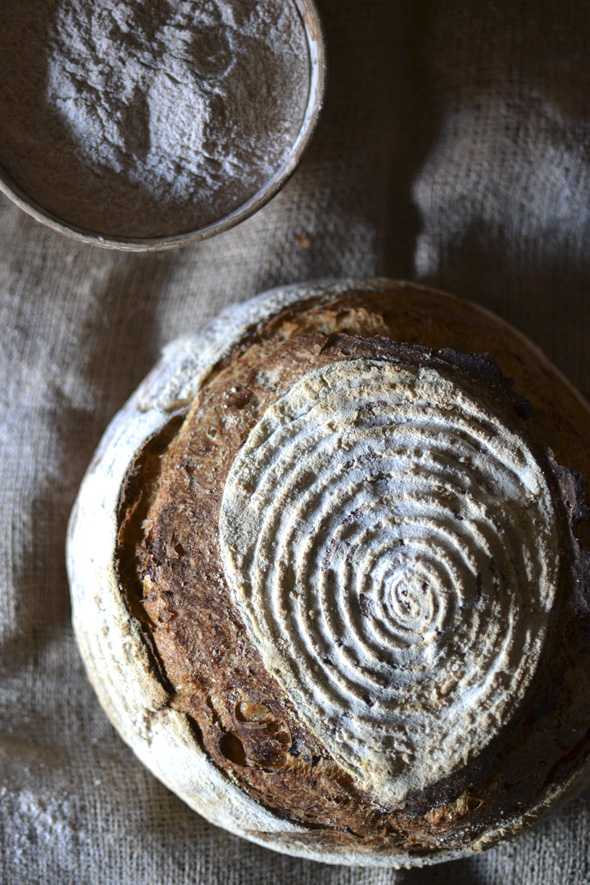
Featured Shop Products
-
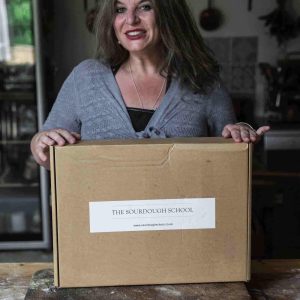
Membership with Beginners Sourdough Baking Kit
£85.00 Buy from our stockist -
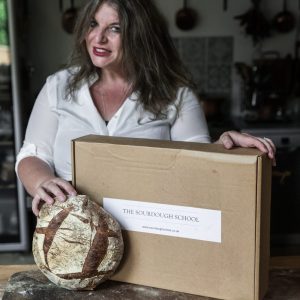
Membership with Sourdough Boule Baking Kit ( Intermediate)
£99.00 Buy from our stockist -
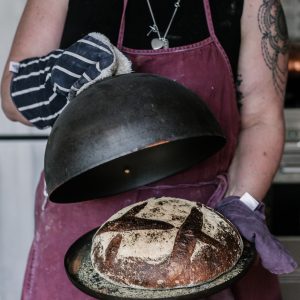
Membership ON SALE – Reduced joining fee from £299 On sale for £99
£9.99 / month after an initial 1 month period for £99.00 including joining fee Join Now

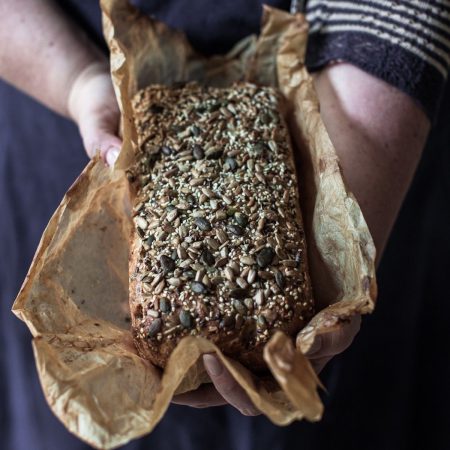
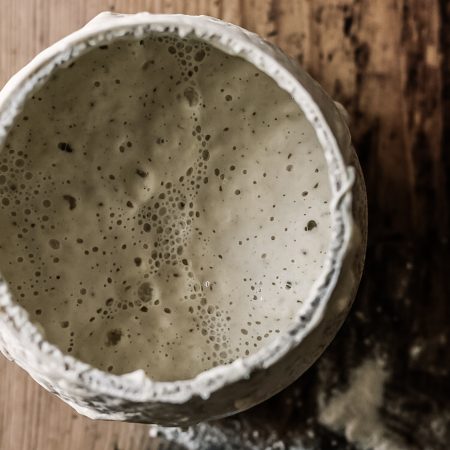
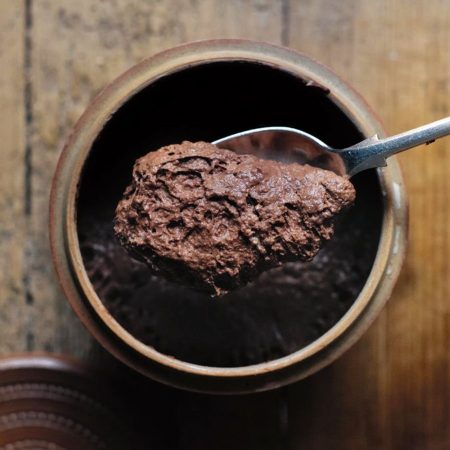
Is the starter supposed to be active when mixed with the potatoes ?
Sorry if it is obvious or if I missed it in the recipe.
Hi Bastien, use the starter when it is at its peak and very active to form the leaven which in this recipe also has the mashed potato in it. Hope this explains it for you.
Just made this recipe and it worked perfectly. I did however use potatoes that had been in the fridge overnight, perhaps that helps with drying them out a little. I also used half wholemeal flour in the mix. Utterly delicious!
I have made this recipe twice now. The first time it was a failure but was at least edible. This time I was at home with all my familiar equipment and my oven. It was worse than before, I ended up with basically a soup that I poured into a lined cast iron casserole dish. I thought it had sort of cooked after about and hour, having taken it out of the dish after 40 minutes or so. It was doughy and undercooked. I really don’t understand where I went wrong?
Why was the dough so wet, It says in the recipe that it seems wet to start with but it just never really became a dough. I thought I had followed the instructions to the letter! I really like potato bread so don’t want to give up.
If your dough is soup-like, it is too wet. When dough is so wet it is soup, that is a disaster that will not produce a loaf.
There are two possibilities. (1) Your flour and/or potatoes are not like the author’s. (2) You didn’t spot all the lines in the recipe where more flour is added. Note, that after putting 120g of starter and 375g of flour into the preferment, then she adds a whole further 1kg of flour in the second stage. That’s 1435g of flour, including 60g of flour in the starter.
If we ignore the potato, the dough is 62% hydration (1435g flour, 885g water, including 60g water from the starter) which is a very dry dough. But some water will be available to the flour from the mashed potatoes. There is a debate on the internet on how much. Part of the issue is that potatoes vary considerably in their make-up, and may also have been mashed together with some of the cooking water. I expect floury potatoes would be drier than waxy/new potatoes, and they will also get drier if they have been stored over winter. I have seen an analysis from a food scientist suggesting for a typical potato, you should expect about 50% of the weight of mashed potato to be water available to the flour, assuming no cooking water is included. If we take that assumption, then adding the 400g of mashed potato is like adding another 200g of water. That implies a dough hydration of 76%.
I can make a self-standing loaf at 76% hydration, but only if I use really strong flour. It would have to be strong Canadian flour, as found in some British shops. If I used typical British bread flour at 76% hydration, (11-12% protein), it could well be soup at 76% hydration. It is close to the edge.
If the potato I was using was a wetter kind, or had some cooking water included, let us say 60% of its weight is now available water. The hydration of the dough is now up to 78%. That could well be soup whatever flour I am using.
So, check the recipe to make sure you followed it exactly. If you did, then you need to put a bit less water in for that kind of flour and potatoes. I would suggest reducing the hydration by about 5% for starters. If you are using the quantities here, that means use about 75ml less water. And hopefully your dough will now come together and not be soup.
Subsequent to writing that, I did a little experiment this morning. I put some mashed potato in a dough I was making, a recipe I have repeated often. Potato was 35% the weight of the flour. I boiled the potatoes whole in their skins, and verified they weighed the same after cooking as before, to ensure I was only adding potato. I peeled them after cooking. I used them to replace half their weight in water in the dough. This made a dough that was too dry. So I added water little by little until the dough had the familiar consistency. I ended up adding back half the water I had withheld. The particular potatoes I used were floury. I didn’t mash them very thoroughly, so there are little lumps of potato visible in the dough. That may be why they didn’t act as so much water. The finished dough, after fermentation, was a bit stickier than usual, but I had no trouble shaping it. The bread came out fluffier inside and with a better crust.
I discussed it with a friend who has also tried including potato in bread. She warned you have to be careful with the water.
So our conclusion is, hold some water back, then add it bit by bit if necessary to get it to a consistency you are happy with.
Another lesson I have had repeatedly is the need to adjust other people’s bread recipes to the particular ingredients and conditions I have available.
I’ve now done another experiment, this time using the essentials of the author’s recipe, though with some small adjustments for my own established ways and timetables of making sourdough.
This time I used a general purpose potato. Again I boiled it whole in the skin and peeled it afterwards to ensure I added only potato. This potato made a much wetter mash than the floury potato a couple of days ago. When I made the final dough mix, I did not feel the need to add any additional water as I did the previous time. The dough had the texture I expected using the approximation that the potato is like 50% its mass of water, though somewhat on the stickier side.
So we learn that potatoes do indeed differ substantially, and you may have to adjust the water for the potato type.
I would normally make a loaf at 75% hydration using strong Canadian flour. This dough was of similar texture, slighly stickier perhaps on first mixing, than my usual 75% hydration dough. By the time bulk fermentation was over, it was very similar. But if I had been using British bread flour, I think I might have been worried at this hydration. I would usually bake at 70% hydration with British bread flour.
I retarded overnight in the fridge after shaping. On turning it out to bake it, the dough was much more self-supporting than usual. I suspect this might be to do with what happens when you cook and then chill for several hours a variety of starchy foods, not just potato but also pasta and rice. The cooked starches partly polymerise in the cold conditions, creating strands of soluble fibre. So my guess would be this fibre formed and was helping hold my dough up.
The author says her loaf is dense. Mine was wonderfully light and elastic, more so than without the potato. So also was the bread I made a couple of days ago that had no cold retardation. I did not follow the suggestion to cook-from-cold, I baked off in a preheated casserole as I normally do. I would want to test cook-from-cold with a dough I am familiar with first so I can understand the difference.
Ivan, thank you for sharing all this information. It is really help to Sourdough Club members. Vx
Is it possible to retard the loaves overnight?
Hello!
This is the first time I will try the recipe but I just want to bake 1 bread. Should I just use half of the measures on the ingredients list?
Thanks 🙂
For example:
60gr 1:1 starter
187.5ml cold water
200g cooked mashed potatoes ( I use organic ones)
137.5g strong white 00 organic bread flour
50g organic wholemeal flour
You can, but I usually encourage people o make an extra one and give one away.
Vx